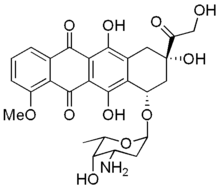Melatonin has been reported to attenuate the oxidative damage caused by doxorubicin on kidney, brain, heart and bone marrow, whereas the in vivo antitumor effects of doxorubicin were not attenuated. The effects of melatonin on doxorubicin cytotoxicity have, therefore, been examined on human normal mammary epithelium HBL-100, on mammary adenocarcinoma MCF-7, on colon carcinoma LoVo, and on mouse P388 leukemia cell lines, and on tumor cell sublines pleiotropically resistant to anthracyclines. Melatonin in the concentration range 10-2000 pg/ mL causes an inhibition of the growth of the human cell lines examined which is not clearly dose-dependent and less than 25% when significant. Melatonin similarly causes minor effects on doxorubicin cytotoxicity either on the parental human cell lines or on their resistant sublines. On the contrary, 200-1000 pg/mL melatonin cause a significant and dose-dependent partial sensitization to doxorubicin of resistant P388 mouse leukemia (P388/ ADR), which occurs also in vivo, as indicated by a significant increase in survival time of the hosts. Doxorubicin intracellular concentrations in P388/ADR cells are increased by melatonin, suggesting that melatonin might inhibit P-glycoprotein-mediated doxorubicin efflux from the cells. These results indicate that the use of melatonin in clinical cancer treatment should not pose the risk of an attenuation of the effectiveness of doxorubicin, and encourage the further examination of the possible reduction by melatonin of the host toxicity of antitumor chemotherapy.
Granzotto M, Rapozzi V, Decorti G, Giraldi T. J Pineal Res 2001;31:206-213.
COPYRIGHT 2001 Thorne Research Inc.
COPYRIGHT 2002 Gale Group



